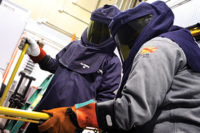 On May 17, 2002, Mr. Carl VanDusen, safety manager for Cable Constructors, Inc., Iron Mountain, MI, wrote OSHA asking for an interpretation the following question:
On May 17, 2002, Mr. Carl VanDusen, safety manager for Cable Constructors, Inc., Iron Mountain, MI, wrote OSHA asking for an interpretation the following question:
Question: Does the OSHA interpretation letter (June 9, 1999) that provided guidance on training non-electrical workers for entry and work within restricted areas such as generating stations and substation also apply for training employees who open restricted equipment for visual inspection only?
Reply: Yes. As explained in the referenced interpretation letter, employers may train workers as qualified employees for the purpose of entering and performing non-electrical work within generating stations, substations, manholes, vaults or similar restricted areas.
The employees you identified are assumed to be non-electrically-qualified workers who will open electrical equipment within restricted areas for visual inspection only. Since these visual inspections would require the removal of enclosures or guards, workers could be exposed via proximity to electric equipment that is energized at levels greater than 50 volts. All employees with direct access to the type of equipment or installations covered by 1910.269 must be trained as required by 1910.269(a)(2)(i) and (ii) in order to meet the definition of a qualified person contained in 1910.269(x).
The training outlined in the referenced interpretation letter specifically addresses employees who are not electrical workers but whose work activity would require exposure to electrical hazards associated with the generation, transmission, or distribution of electrical power. Therefore, the minimum acceptable training for the workers described in your scenario would include the training outlined in the June 1999 letter. Those requirements are provided below for your reference:
1. They must know what is and is not safe to touch in the specific areas they will be entering [paragraph 1910.269(a)(2)(ii)(A)].
2. They must know the maximum voltage of the area [paragraph 1910.269(a)(2)(ii)(B)].
3. They must know the minimum approach distances for the maximum voltage within the area [paragraph 1910.269(a)(2)(ii)(C)].
4. They must be trained in the recognition and proper use of protective equipment that will be used to provide protection for them and in the work practices necessary for performing their specific work assignments within the area [paragraph (a)(2)(ii)(D)]. (Note: Only fully qualified electrical employees may install insulating equipment on energized parts.)
Until these “qualified employees” have demonstrated proficiency in the work practices involved with their work, they are considered to be employees undergoing on-the-job training and must be under the direct supervision of a qualified person at all times. According to the definition of “qualified employee” the employee must also have demonstrated an ability to perform work safely at his or her level of training. It is expected that an orientation familiarizing the employee with the safety fundamentals given here will be conducted before an employee undergoing training is allowed to enter a restricted area.
As you may know, the state of Michigan operates its own occupational safety and health program under a plan supervised by federal OSHA. State plans are required to promulgate regulations that are, “at least as effective” as the federal standards, but they may also be more stringent.
We hope you find this information helpful. OSHA requirements are set by statute, standards, and regulations. Our interpretation letters explain these requirements and how they apply to particular circumstances, but they cannot create additional employer obligations. This letter constitutes OSHA's interpretation of the requirements discussed. Note that our enforcement guidance may be affected by changes to OSHA rules. Also, from time to time we update our guidance in response to new information. To keep apprised of such developments, you can consult OSHA's website at http://www.osha.gov.
Sincerely,
Richard E. Fairfax, Director
Directorate of Compliance Programs



